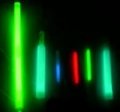
Infrared and nuclear magnetic resonance spectroscopy are anything but child’s play, but now US chemists have used these techniques to follow the chemistry of “light sticks” and to develop a light-free version of photochemistry. This contradiction in terms could be exploited in a remote cure process for photopolymers, they say, allowing inaccessible cracks in pipes, joints or containers, to be sealed as well as having other practical applications in coatings, paints, varnishes, adhesives and sealants.
Light sticks hold children’s parties in awe with their eerie yellow-green glow as well as providing emergency lighting without electricity or a naked flame. The chemistry taking place when the stick is “snapped” and the materials mix involves oxalyl chloride and hydrogen peroxide reacting in the presence of a fluorophore, which emits light as the reaction proceeds.
Read the full story in the latest news round up from David Bradley on SpectroscopyNOW.com